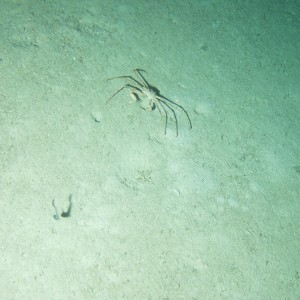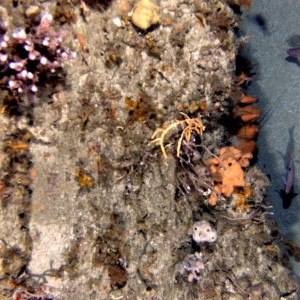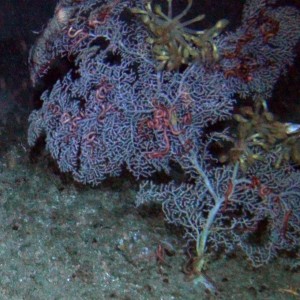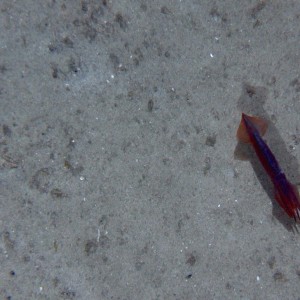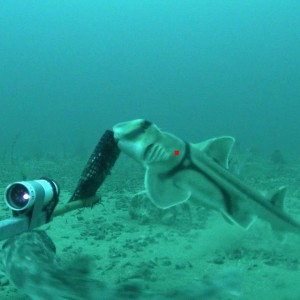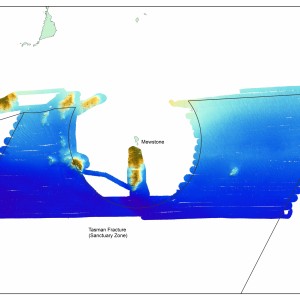A black tree coral on Joe's Reef, Freycinet Marine Park, dwarfs the diverse sponge and invertebrate community beneath it. Black corals are named after the black colour of their skeleton, and their living tissue can take on a variety of bright colours, including white.
 by James Parkinson
by James ParkinsonThe boundary between sand habitat (on the right) and low profile reef habitat (on the left) in 90 metres depth in the Freycinet Marine Park. The boundary is marked by a distinct change in slope and a change from bare sand to a sandy/invertebrate turf cover. It is also often demarcated by dense clusters of brittle stars, potentially due to enhanced food availability due to enhanced current speeds or accumulation of detritus at the reef base. Generally these “relict coastline” reefs are very low profile as shown here, and have quite low invertebrate cover with few larger sponges.
 by Institute of Marine and Antarctic Studies
by Institute of Marine and Antarctic StudiesRV Challenger at the CSIRO wharf in Hobart ready for June 2012 Flinders Marine Park survey, with Baited under water video (shallow), Deep-water CSIRO Baited underwater video (topped with brightly coloured floats), plus the CSIRO Towed Video system. This NERP Hub cruise deployed baited underwater video and towed video over previously mapped seabed within the Flinders Marine Park to quantitatively determine the distribution of species and habitats within the shelf and upper slope of the Marine Park based on a GRTS-based statistical framework for spatially balanced sampling and inference.
 by Institute of Marine and Antarctic Studies, CSIRO
by Institute of Marine and Antarctic Studies, CSIROIn 2009 JASON Remotely Operated Vehicle (ROV) (belonging to the Woods Hole Oceanographic Institution) undertook a voyage in the Tasman Fracture Zone off south-east Tasmania. This is a still image taken at 4006 metres showing deep water stalked carnivorous ascidian (Family Octacnemidae) approximately 50 centimetres in height. The ascidian works similar to a venus fly-trap, using the funnel-like appendage to collapse around prey that move past.
 by CSIRO
by CSIROLaunching an Integrated Marine Observing System autonomous underwater vehicle in Flinders Marine Park.
 by Institute of Marine and Antarctic Studies
by Institute of Marine and Antarctic StudiesA still image of the benthos taken from an AUV in the Flinders Marine Park.
 by Institute of Marine and Antarctic Studies
by Institute of Marine and Antarctic StudiesStill image from AUV of a mid-shelf reef ledge at 60 metres depth in the Flinders Marine Park showing lobster antennae, butterfly perch (both associated with the ledge feature), sponges and the usual biogenic matrix.
 by IMOS, Institute of Marine and Antarctic Studies
by IMOS, Institute of Marine and Antarctic StudiesThe most accessible dive site in the Freycinet Marine Park (South-east Network) is known to local fishers as ‘Joe’s Reef’, an unusual 200m-long granite reef surrounded by sandy substrate. This reef is located 11 km off the coast and sits between 59–83m depth. Large numbers of tree-forming black corals amongst spectacularly diverse gardens of sponges, soft corals and bryozoans.
 by James Parkinson
by James ParkinsonAn Eastern Rock Lobster (Sagmariasus verreauxi) foraging on a deep reef within the Huon Marine Park. Note the white coloration on the lobster, a typical feature of lobsters on deep shelf reefs in Tasmanian coastal waters. It is only when lobsters forage in shallower water that they attain their typical red colouration, a result of the higher abundance of carotinoid pigments in the marco- and encrusting algal assemblages which upon consumption will accumulate in the lobster's exoskeleton. Lobsters are regularly seen in AUV imagery from the Huon Marine Park.
 by Institute of Marine and Antarctic Studies
by Institute of Marine and Antarctic StudiesThis image of a Gould's squid (arrow squid/dart squid/Nototodarus gouldi) was taken by an Autonomous Underwater Vehicle (AUV) during a survey in the Freycinet Marine Park. Gould's squid are a schooling species that inhabit coastal and nearshore waters, preferring shallow reef, sand and seagrass habitats on the continental shelf. Gould's squid are typically light-brownish pink to brick red in colour, but like other cephalopods they can change the colour of their skin in the blink of an eye. This allows them to either mimic the colours of their surrounding environment and render themselves almost invisible to predators, or alternatively give themselves a colour or pattern that makes them stand out.
 by Institute of Marine and Antarctic Studies
by Institute of Marine and Antarctic StudiesIn 2009, the JASON Remotely Operated Vehicle (ROV) belonging to the Woods Hole Oceanographic Institution undertook a voyage in the Tasman Fracture Zone off south-east Tasmania. This huge "waffle-cone" glass sponge (species unknown) was photographed at approximately 2197 metres.
 by CSIRO
by CSIROIn September 2016 Hub researchers undertook a survey of the benthic fauna of the Freycinet Marine Park with an Autonomous Underwater Vehicle (AUV). While there, they encountered a significant number of Humpback whales that were passing through on their southward migration to Antarctic feeding grounds for summer.
 by Institute of Marine and Antarctic Studies, NESP Marine Biodiversity Hub
by Institute of Marine and Antarctic Studies, NESP Marine Biodiversity HubIstigobius decoratus, known as the Decorated Sandgoby is found on sand patches near reefs.
 by Ian Shaw
by Ian ShawA still image of a killer whale (Ocinus ocra) caught on camera during a BRUV deployment in a canyon-head incision of the shelf edge within the Flinders Marine Park (depth of 160 metres). The video shows numerous stripey trumpeter and a large rock lobster attracted to the bait before a killer whale passes overhead, scattering the trumpeter, who then turn and follow the whale. This illustrates the likely hot spot of productivity associated with such canyon-head upwelling areas, that is a focus for top predators like killer whales, and piscivorous fish such as stripey trumpeter.
 by Institute of Marine and Antarctic Studies
by Institute of Marine and Antarctic StudiesA still image from video showing a Mako shark approaching BRUV deployed at the shelf edge near a canyon-head incision (depth of 140 metres). This is an example of the range of species attracted to BRUV's, and the potential of the canyon-head incision areas to be productivity hotspots, targeted by top predators like mako sharks, seals and killer whales.
 by Institute of Marine and Antarctic Studies
by Institute of Marine and Antarctic StudiesPleurosicya mossambica also known as the toothy goby or the Mozambique ghost goby is found on many substrates, including corals, sponges, giant clams and seaweeds, and can vary colour according to the substrate.
 by Ian Shaw
by Ian ShawA still image of a Port Jackson shark (Heterodontus portusjacksoni) attracted to a BRUV in the Flinders Marine Park. Port Jackson sharks are well known to most divers and fishermen in southern Australia, where they commonly occur near the seafloor foraging on bottom dwelling invertebrates at night and returning to rocky caves and ledges to rest during the day. The spirally flanged egg cases of these creatures can also be observed wedged into reef crevices, where the young develop over a period of a year before hatching.
 by Institute of Marine and Antarctic Studies
by Institute of Marine and Antarctic StudiesThis is an AUV still image showing habitat of the Freycinet Marine Park at ~89 metres, including sandy substrate, sea pens and sponges. Sea pens are colonial marine organisms and each individual pen is made up of many animals. These animals are called polyps and they look like miniature anemones with eight tentacles which they use to catch plankton and other small organisms from the water column to feed. Sea pens typically occur in deeper waters where there is less turbulence, and unlike most soft corals they occur in soft sandy environments, anchoring themselves in the sediment with a bulbous base.
 by Institute of Marine and Antarctic Studies
by Institute of Marine and Antarctic StudiesThis stingeree was captured on camera during an AUV survey in the Freycinet Marine Park in June 2011. Stingerees are a family of rays within the order Myliobatiformes (commonly known as stingrays). They are relatively small compared to some of their cousins, typically measuring between 15-80 centimetres in length. They live on the bottom in sandy habitats on the shelf and upper regions of the continental slope, where they eat a variety of invertebrates, crustaceans and small fish that they trap beneath them and manoeuvre into their mouth by flexing their disc flaps. Half buried in sand, they are often very difficult to see, and divers, swimmers and snorkelers should be wary of the two venomous spines on the end of their tails.
 by Institute of Marine and Antarctic Studies
by Institute of Marine and Antarctic StudiesA still image taken from BRUV video (depth 160 metres) to illustrate the potential for stripey trumpeter to be a key indicator species within the Flinders Marine Park, and the extent that canyon-head incisions in the shelf in this Marine Park are productivity hotspots that are actively targeted by stripey trumpeter. Presumably the bait fish species attracted to the hotspot are a significant source of food for the piscivorous trumpeter, and the exposed deep-water reef system at the canyon head appears to provide optimal habitat for the trumpeter. Upwelling (or downwelling) curents at the canyon head are thought keep the deep reef systems from being buried in sediments.
 by Institute of Marine and Antarctic Studies
by Institute of Marine and Antarctic StudiesA map of the Tasman Fracture Marine National Park Zone, surrounding the Mewstone, that was mapped during the survey in 2014.
 by Institute of Marine and Antarctic Studies
by Institute of Marine and Antarctic Studies



